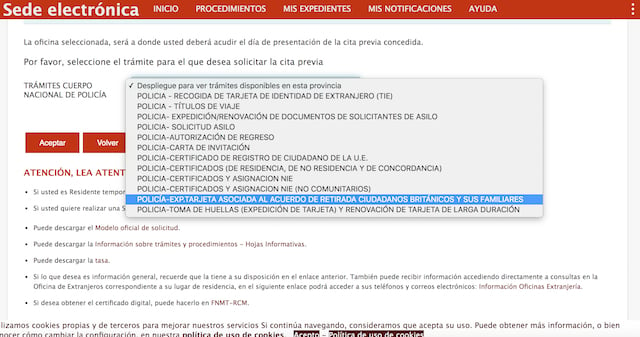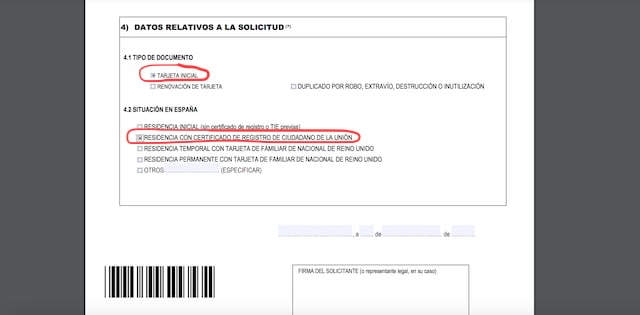TIE cards were first introduced for Britons in Spain in July 2020, but Spanish authorities and the UK Embassy in Madrid repeatedly stressed that it remained “optional” to exchange the green residency documents for these new biometric cards, as the old paper certificates are still valid under the Withdrawal Agreement, with no end date set or even implied.
While it’s still up to the individual to decide whether to exchange their Certificado de Registro de Ciudadano de la Unión (aka the green residency certificate) for a Tarjeta de Identidad de Extranjero (the new TIE for Brits as non-EU nationals), UK and Spanish authorities have been recommending since mid-2021 that you should.
The benefits according to UK Ambassador in Spain Hugh Elliott include the card’s durability, the ease it can provide in border crossings and that it has a photo, all qualities the green residency document lacks to a greater or lesser extent.
But, in September 2023, study by Spain’s immigration observatory revealed that from July 2020 to June 2023 only 159,604 UK nationals had successfully exchanged their old residency documents for a TIE.
This means over half of the total number of Britons in Spain – 293,171 people to be exact (according to data from Spain’s National Statistics Institute INE for 2022) have not exchanged their old EU residency certificate for the TIE.
In fact, just last month, in March 2024, the British Embassy in Madrid again urged anyone who hasn’t exchanged their card to do so. In a statement on their Facebook page they said: “We advise all British people in Spain to get the TIE, the most reliable way to prove your rights under the Withdrawal Agreement. But we know that lots of Brits still have a Green Certificate and – although it is valid proof of the right to reside in Spain – are encountering difficulties with its recognition”.
In order to help, they have created this letter to give to authorities.
If you have indeed decided to exchange your old residency document for a TIE, here’s our step-by-step guide on how to do it, as well as some useful advice regarding the process as well as regional differences.
First step – get an appointment
The first step in the process is to go on the cita previa website, choose your province and select the option POLICIA-TOMA DE HUELLA (EXPEDICIÓN DE TARJETA), RENOVACIÓN DE TARJETA DE LARGA DURACIÓN Y DUPLICADO

Here, you will be asked to fill out your details and will be issued with a date and time for your appointment. It can sometimes take a few weeks of trying to get your appointment if none are available. In some parts of Spain with fewer Britons, you may be able to get an appointment within a matter of days.
However, even if you’re lucky enough to secure an appointment for the next day, this would give you very little time to get the necessary documents together, so give yourself at least a few days to get everything ready and the processes completed. In fact, there’s nothing stopping you from starting with step two before step one to be truly prepared.
Step Two – Gathering your documents
- Fill in the EX-23 TIE application form and print it out to hand in during your appointment. DOWNLOAD HERE. This is pretty straightforward. You will need to fill out all your personal details such as name, date of birth, address, and NIE. At the bottom where it says Datos Relativos a la Solicitud you need to check Tarjeta Inicial because this will be the first time you will be applying for a TIE. In the second box, you should check Residencia con Certificado de Registro de Ciudadano de la Unión.

- Get a passport photo of yourself. To be completely sure it meets the requirements, have this done at a shop or photography studio where Spanish DNI (Spanish National ID) photos are taken.
- If you have changed address since your green certificate was last issued, then you may need to show a padrón certificate issued within the last three months. It’s advisable that you secure a cita previa (appointment) for this before you begin the TIE exchange process.
- To be on the safe side, get photocopies done of your padrón, passport and green certificate.
- Fill in ‘modelo 790’ (code 012), in order to pay the processing fee at a bank. They will stamp the form to prove that you have paid or direct you to the ATM to use the system there. Take this receipt along to your appointment. Sometimes you can do this in the middle of your appointment and then go back to show your receipt when you’ve done so, but it’s not always advisable.
READ ALSO: Empadronamiento in Spain: What is it and how do I apply?
Step Three – Going to your appointment
Your appointment will take place at the local police station, where you will need to bring all the necessary documents as described above. This may not necessarily be the police station that’s part of the extranjería office where initial residency applications for Brits are processed, so make sure you take note of the address when booking the appointment.
During the appointment, a police officer or civil servant will check all your documentation and may ask you several questions. Then they will take your fingerprints for processing.
Be aware that even in big cities such as Barcelona, most of the staff do not speak English, so the conversation will most likely be in Spanish, in case you need to take someone along to translate.
If all the documents are in order and you’ve paid your fee, you’ll be issued with a receipt called a resguardo, to say that your application has been successful.
Step Four – Picking up your TIE card
It can take a month or more for your TIE card to be processed. In some regions, you’ll be issued with a notification when it’s ready, while in others you may have to apply for a second appointment to collect your card, after a certain amount of time has passed.
When you go to pick up your TIE card, remember to bring your resguardo, your passport and your old green certificate, the latter police will most likely keep after they hand you your TIE.
Your fingerprints will be checked again and then you’ll be issued with your new TIE card. Check the card carefully before you leave the station, just to make sure all the information is correct.
READ ALSO: BREXIT: The two mistakes to look out for on your TIE Spanish residency card
If you’ve been a resident for less than five years, you’ll receive the TIE valid for five years, while if you have been a resident for more than five years, you will be given a larga duración (long-term) TIE, which is valid for 10 years before it has to be renewed.
Top tips and differences between the regions
Many people have been asking on expat forums for contact details of lawyers and gestores (a type of accountant and legal aid) to help them through the exchange process. This is not really necessary, it’s very straightforward and easy to do compared to initial residency applications for Britons who haven’t previously registered in Spain or for those getting the non-lucrative visa.
Generally speaking, you do not need to pay someone to assist you with this residency document exchange.
READ ALSO: What does a ‘gestor’ do in Spain and why you’ll need one
Appointments can be hard to come by in many regions across Spain, with many people waiting weeks to get one. This is partly to do with appointments being block-booked by gestores or immigration companies who will charge you a fee to get you an appointment.
If you need your appointment urgently, then it might be worth contacting one of these companies, but if not just wait it out and you will eventually get one if you keep trying.
Córdoba
Some readers in Córdoba have reported that the process is very straightforward and easy there and that waiting times for appointments and collection of the card are not long.
Alicante
Some readers in Alicante have told The Local Spain that you will get a notification when your TIE is ready, but that you need to make an appointment to go and collect it.
Almería
Those looking to exchange cards in Almería have found it very difficult lately with almost no appointments available.
Valencia
Our Valencia readers have reported you won’t be notified when it’s ready, but you’ll need to check online to find out when your number comes up and you can collect it.
Málaga
Britons in Málaga have reported that you won’t be notified when it’s ready, but may be told when to return to collect it or be given a number to check when it’s been processed.
Canary Islands
Readers in the Canary Islands have said it’s not necessary to get an appointment to pick up your card.
Catalonia
In Catalonia, and particularly in Barcelona, the main issue seems to getting the second appointment to pick up your card. It can take months to be able to get an appointment to pick it up, but keep trying. Some people have reported that new appointments are released on Friday mornings, so that may be a good time to check. Cards must be picked up from the police station on Calle Mallorca, not the one on Rambla Guipúscoa where you go for your initial appointment and fingerprinting.



 Please whitelist us to continue reading.
Please whitelist us to continue reading.
Member comments